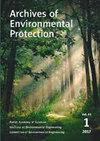Biosorption of Pb(II) by the resistant Enterobacter sp.: Investigated by kinetics, equilibriumand thermodynamics
IF 1.3
4区 环境科学与生态学
Q4 ENVIRONMENTAL SCIENCES
引用次数: 2
Abstract
The Pb(II)-resistant bacterium was isolated from heavy metal-contained soils and used as a biosorbent to remove Pb(II). The strain was identified as Enterobacter sp. based on the 16S rRNA sequence analysis. The effect of biosorption properties (pH value, Pb(II) concentration, bacterial concentration and temperature) on Pb(II) was investigated by batch experiments. Results of FTIR and XPS showed that the biosorption process mainly involved some oxygen-containing groups (-OH and -COOH groups). The experimental results and equilibrium data were fitted by pseudo-second-order kinetic model and Langmuir model, respectively. The experimental biosorption isotherms fitted the Langmuir model, and the maximum biosorption capacity was 40.75 mg/g at 298 K. The calculated ΔGо and ΔHо were –4.06 and 14.91(kJ/mol), respectively, which indicated that biosorption process was spontaneous and endothermic. Results show that Enterobacter sp. will be an efficient biosorbent for Pb(II) removal. Biosorption of Pb(II) by the resistant Enterobacter sp.: Investigated by kinetics, equilibrium and thermodynamics 29 et al. have found that Enterobacter sp. RC4 was capable of reducing crude oil content by 80%, which has been widely used (Baruah et al. 2016). Pb(II) biosorption by Enterobacter sp. is theoretically feasible, but to the best of our knowledge, there is no report on Pb(II) biosorption by Enterobacter sp., therefore, the use of Enterobacter sp. to adsorb Pb(II) has certain significance. The objectives of this study are as follows: (1) The strong Pb(II) resistant Enterobacter sp. was isolated from the Pb(II)-contaminated soils. (2) The influence of solution pH value, uptake time and biosorption doses on biosorption were investigated systematically. (3) XPS and FTIR were used to analyze the change elements and different functional groups on the surface of bacteria, respectively, and the morphological changes were analyzed by TEM. (4) The biosorption kinetics, thermodynamics and isotherm of Enterobacter sp. for Pb(II) were studied. Materials and methods Cultivation of biosorbent and identification The biosorbent was isolated from the Pb(II)-contaminated soils, and the samples (Pb(II)-contaminated soils) were stored in the School of Environment and Chemical Engineering, Anhui Vocational and Technical College. The strain was isolated by a specific method and was similar to the previous studies (Liu et al. 2018, 2019). Firstly, 10 g of soil sample was dissolved in 100 mL of sterile water, then the supernatant was gradually diluted to 10-4 times. Secondly, 1 mL of the dilution was spread on a nutrient agar plate (5 g/L of peptone, 1 g/L of glucose, 2.5 g/L of yeast extract) containing 100 g/L of Pb(II) ion, which was incubated for 24 hours at 37°C. Finally, the single colony was obtained for molecular identification and biosorption experiments. The methods used for the cultivation of Enterobacter sp. were the same as the methods for screening and separating. DNA was extracted from the isolated bacteria for PCR amplification. The amplified sequences were searched for homology in NCBI database. Reagents and Characterization methods The Pb(II) stock solution (500 mg/L) was prepared by dissolving Pb2(NO3)2 in deionized water. Other reagents were analytical grade. The morphology of Pb(II)-loaded Enterobacter sp. was investigated using carbon dioxide critical point dryer (Emitech K850) and Transmission Electron Microscope (TEM) (Hitachi, HT-7700). The specific method was as follows: firstly, the cultured cells were centrifuged at 3000 rpm for 5 minutes, resuspended in physiological saline, repeated 3 times, and then dehydrated with 25%, 50%, 70%, 80%, and 90% ethanol solutions. Secondly, the dehydrated cells were fixed in 25% glutaraldehyde at 4°C for 12 hours., then rinsed with phosphate buffer solution 3 times, and then the sample was fixed with 1% osmium acid. Finally, the sample was mixed with embedding agent and acetone, and then dried overnight at 70°C. The chemical groups of Enterobacter sp. were performed by Fourier Transform Infrared Spectrometer (FTIR) (Thermo Scientific IS10, USA) in the wave number range 4000–500 cm-1. The Elemental analysis was measured using X-ray photoelectron spectroscopy (XPS) (Thermo, ESCALAB250Xi, USA). Biosorption experiments The biosorption experiments were conducted at pH 6.0 and 0.01 mol/L KCl. Briefly, 1.0 mL of 0.5 mol/L KCl, 44.0 mL sterile water, 5.0 mL of 500 mg/L Pb(II) stock solution and 0.1 g Enterobacter sp. suspension (wet cell) were mixed. After equilibrium of 2 h, the liquid phase was separated from solid phase by centrifugation at 8000 rpm for 5 min. The concentration of Pb(II) in supernatant solutions was measured by UV spectrophotometry. The Enterobacter sp. was collected by centrifugation, and then the cells were weighed according to the amount of biosorbent on the effectiveness of Pb(II) biosorption. In the 50 mL biosorption system, 0.1 mol/L of sodium hydroxide and hydrochloric acid were used to adjust the pH of the biosorption system. The removal percentage (R, %), biosorption capacity (Q, mg/g) and distribution coefficient (K, mL/g) were determined by the following Eqns. (1–3) (Bobik et al. 2017, Wang et al. 2017, Wang et al. 2009):耐药肠杆菌对铅(II)的生物吸附:动力学、平衡和热力学研究
用1 mol/L的氢氧化钠和盐酸调节生物吸附体系的pH。去除率(R, %)、生物吸附量(Q, mg/g)和分配系数(K, mL/g)由下式确定。(1-3) (Bobik et al. 2017, Wang et al. 2017, Wang et al. 2009):
本文章由计算机程序翻译,如有差异,请以英文原文为准。
求助全文
约1分钟内获得全文
求助全文
来源期刊

Archives of Environmental Protection
ENVIRONMENTAL SCIENCES-
CiteScore
2.70
自引率
26.70%
发文量
0
期刊介绍:
Archives of Environmental Protection is the oldest Polish scientific journal of international scope that publishes articles on engineering and environmental protection. The quarterly has been published by the Institute of Environmental Engineering, Polish Academy of Sciences since 1975. The journal has served as a forum for the exchange of views and ideas among scientists. It has become part of scientific life in Poland and abroad. The quarterly publishes the results of research and scientific inquiries by best specialists hereby becoming an important pillar of science. The journal facilitates better understanding of environmental risks to humans and ecosystems and it also shows the methods for their analysis as well as trends in the search of effective solutions to minimize these risks.
 求助内容:
求助内容: 应助结果提醒方式:
应助结果提醒方式:


